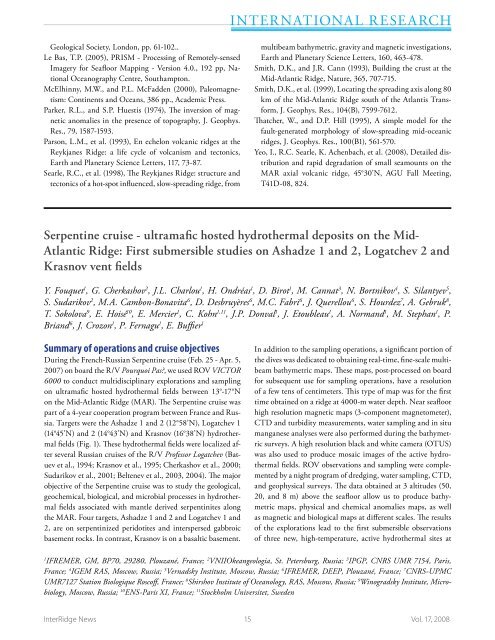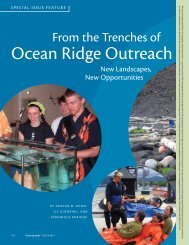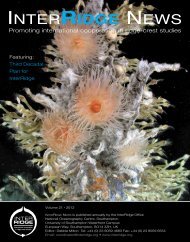Full version, lower resolution, 3.25MB - InterRidge
Full version, lower resolution, 3.25MB - InterRidge
Full version, lower resolution, 3.25MB - InterRidge
You also want an ePaper? Increase the reach of your titles
YUMPU automatically turns print PDFs into web optimized ePapers that Google loves.
International Research<br />
Geological Society, London, pp. 61-102..<br />
Le Bas, T.P. (2005), PRISM - Processing of Remotely-sensed<br />
Imagery for Seafloor Mapping - Version 4.0., 192 pp, National<br />
Oceanography Centre, Southampton.<br />
McElhinny, M.W., and P.L. McFadden (2000), Paleomagnetism:<br />
Continents and Oceans, 386 pp., Academic Press.<br />
Parker, R.L., and S.P. Huestis (1974), The in<strong>version</strong> of magnetic<br />
anomalies in the presence of topography, J. Geophys.<br />
Res., 79, 1587-1593.<br />
Parson, L.M., et al. (1993), En echelon volcanic ridges at the<br />
Reykjanes Ridge: a life cycle of volcanism and tectonics,<br />
Earth and Planetary Science Letters, 117, 73-87.<br />
Searle, R.C., et al. (1998), The Reykjanes Ridge: structure and<br />
tectonics of a hot-spot influenced, slow-spreading ridge, from<br />
multibeam bathymetric, gravity and magnetic investigations,<br />
Earth and Planetary Science Letters, 160, 463-478.<br />
Smith, D.K., and J.R. Cann (1993), Building the crust at the<br />
Mid-Atlantic Ridge, Nature, 365, 707-715.<br />
Smith, D.K., et al. (1999), Locating the spreading axis along 80<br />
km of the Mid-Atlantic Ridge south of the Atlantis Transform,<br />
J. Geophys. Res., 104(B), 7599-7612.<br />
Thatcher, W., and D.P. Hill (1995), A simple model for the<br />
fault-generated morphology of slow-spreading mid-oceanic<br />
ridges, J. Geophys. Res., 100(B1), 561-570.<br />
Yeo, I., R.C. Searle, K. Achenbach, et al. (2008), Detailed distribution<br />
and rapid degradation of small seamounts on the<br />
MAR axial volcanic ridge, 45°30’N, AGU Fall Meeting,<br />
T41D-08, 824.<br />
Serpentine cruise - ultramafic hosted hydrothermal deposits on the Mid-<br />
Atlantic Ridge: First submersible studies on Ashadze 1 and 2, Logatchev 2 and<br />
Krasnov vent fields<br />
Y. Fouquet 1 , G. Cherkashov 2 , J.L. Charlou 1 , H. Ondréas 1 , D. Birot 1 , M. Cannat 3 , N. Bortnikov 4 , S. Silantyev 5 ,<br />
S. Sudarikov 2 , M.A. Cambon-Bonavita 6 , D. Desbruyères 6 , M.C. Fabri 6 , J. Querellou 6 , S. Hourdez 7 , A. Gebruk 8 ,<br />
T. Sokolova 9 , E. Hoisé 10 , E. Mercier 1 , C. Kohn 1,11 , J.P. Donval 1 , J. Etoubleau 1 , A. Normand 1 , M. Stephan 1 , P.<br />
Briand 6 , J. Crozon 1 , P. Fernagu 1 , E. Buffier 1<br />
Summary of operations and cruise objectives<br />
During the French-Russian Serpentine cruise (Feb. 25 - Apr. 5,<br />
2007) on board the R/V Pourquoi Pas?, we used ROV VICTOR<br />
6000 to conduct multidisciplinary explorations and sampling<br />
on ultramafic hosted hydrothermal fields between 13°-17°N<br />
on the Mid-Atlantic Ridge (MAR). The Serpentine cruise was<br />
part of a 4-year cooperation program between France and Russia.<br />
Targets were the Ashadze 1 and 2 (12°58’N), Logatchev 1<br />
(14°45’N) and 2 (14°43’N) and Krasnov (16°38’N) hydrothermal<br />
fields (Fig. 1). These hydrothermal fields were localized after<br />
several Russian cruises of the R/V Professor Logatchev (Batuev<br />
et al., 1994; Krasnov et al., 1995; Cherkashov et al., 2000;<br />
Sudarikov et al., 2001; Beltenev et al., 2003, 2004). The major<br />
objective of the Serpentine cruise was to study the geological,<br />
geochemical, biological, and microbial processes in hydrothermal<br />
fields associated with mantle derived serpentinites along<br />
the MAR. Four targets, Ashadze 1 and 2 and Logatchev 1 and<br />
2, are on serpentinized peridotites and interspersed gabbroic<br />
basement rocks. In contrast, Krasnov is on a basaltic basement.<br />
In addition to the sampling operations, a significant portion of<br />
the dives was dedicated to obtaining real-time, fine-scale multibeam<br />
bathymetric maps. These maps, post-processed on board<br />
for subsequent use for sampling operations, have a <strong>resolution</strong><br />
of a few tens of centimeters. This type of map was for the first<br />
time obtained on a ridge at 4000-m water depth. Near seafloor<br />
high <strong>resolution</strong> magnetic maps (3-component magnetometer),<br />
CTD and turbidity measurements, water sampling and in situ<br />
manganese analyses were also performed during the bathymetric<br />
surveys. A high <strong>resolution</strong> black and white camera (OTUS)<br />
was also used to produce mosaic images of the active hydrothermal<br />
fields. ROV observations and sampling were complemented<br />
by a night program of dredging, water sampling, CTD,<br />
and geophysical surveys. The data obtained at 3 altitudes (50,<br />
20, and 8 m) above the seafloor allow us to produce bathymetric<br />
maps, physical and chemical anomalies maps, as well<br />
as magnetic and biological maps at different scales. The results<br />
of the explorations lead to the first submersible observations<br />
of three new, high-temperature, active hydrothermal sites at<br />
1<br />
IFREMER, GM, BP70, 29280, Plouzané, France; 2 VNIIOkeangeologia, St. Petersburg, Russia; 3 IPGP, CNRS UMR 7154, Paris,<br />
France; 4 IGEM RAS, Moscow, Russia; 5 Vernadsky Institute, Moscow, Russia; 6 IFREMER, DEEP, Plouzané, France; 7 CNRS-UPMC<br />
UMR7127 Station Biologique Roscoff, France; 8 Shirshov Institute of Oceanology, RAS, Moscow, Russia; 9 Winogradsky Institute, Microbiology,<br />
Moscow, Russia; 10 ENS-Paris XI, France; 11 Stockholm Universitet, Sweden<br />
<strong>InterRidge</strong> News 15 Vol. 17, 2008
















